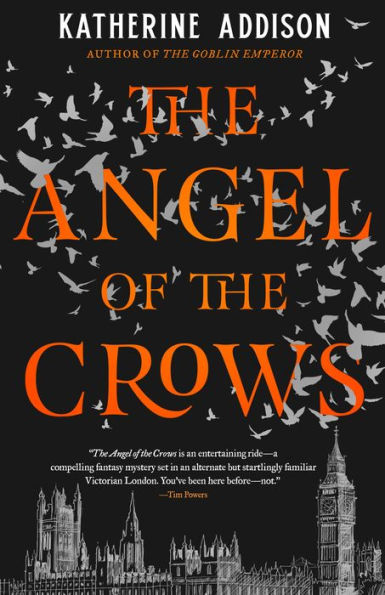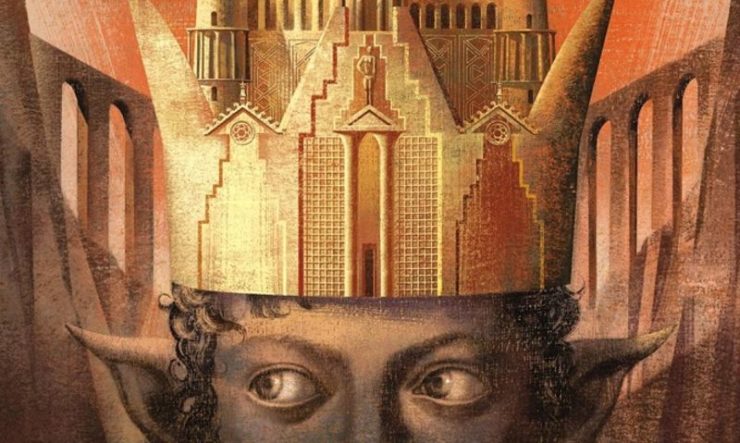When my editor asked if I wanted to write a column about The Goblin Emperor to go along with the #TorDotReads read-along, I was absolutely delighted to be able to re-read this book that’s like reading a hug. This column is going to be a little different than previous ones, not only because it’s the first fantasy novel I’ve talked about, but also in its structure. So, come along with me as I work out how Ethuveraz titles and names work, based on the vocabulary we’re given!
At the start of the novel, pure cinnamon roll Maia Drazhar is awakened by his horrible cousin/guardian Setheris to find out that Maia’s father, the emperor of the elflands (who hates Maia), and his three older half-brothers (the most likely heirs to the throne) were killed in an airship crash. So now Maia has to go from the remote town where he’s been relegated since his goblin mother died to the capital and become emperor. He has to adjust to a lot of things, including his permanent cadre of bodyguards, valets, cooks, and other staff, while also setting about solving the mystery of who murdered his father. His secretary, Csevet Aisava, is absolutely invaluable in his quest.
The language of Ethuveraz isn’t extensively developed in the book. We have a few dozen vocabulary words, which make use of derivational morphology, plus place names, and titles of address (the equivalents of Mr. or Ms. or Mx.). We have a consistent phonology, with lots of kh and zh.
One thing I remember from a few years ago, when TGE was first published, was people saying they couldn’t follow all the names and titles—so I said to myself, “self, let’s see if we can derive the rules for titles based on what we have in the book. An exercise in field linguistics.” If the author can engineer the system, I can reverse engineer it.
I’ll also talk about the dinner party scene where the philologist nobleman gets excited about a new bit of information (#relatable), and the pronoun scheme (which is pretty cool).
Vocabulary
Buy the Book


The Angel of the Crows
-eise is used as an adjectival suffix for a place of origin. Barizhad is the noun for the neighboring goblin kingdom, and Barizheise is its adjectival form.
Meire is a word meaning temple, and it is often used in compound words, like Ulimeire, the temple of Ulis.
-theileian means hall, and Maia holds court in the Michen’theileian, the lesser hall. His smaller meetings are held in the Verven’theileian, the hall of consultation.
Maia’s jewels are the dachen (greater) and michen (lesser) mura (jewels), and the crown is the Ethuverazhid mura, the Ethuverazian jewels.
His bodyguards are the nohecharei, singular nohecharis (m), nohecharo (f). His valets (gentlemen of the chamber) are the edocharei, singular edocharis (m), presumptive feminine edocharo. This implies that -charis is a root noun referring to the chambers, and nohe- and edo- have a specifying function, but I don’t know exactly what, and I don’t believe I have enough information to comment further.
Maza (pl mazei) are the guardians of the emperor’s spirit, i.e. mages. Their temple/academy is the Athmaz’are, and a person who is associated with this academy takes Athmaza as a surname, as in Cala Athmaza, a nohecharis. The head of the Athmaz’are is the Adremaza, the master of the maza. The word maz by itself is a spell, and we have the Mazen’theileian, the hall of the mages at the court.
So, we have some morphemes. Now let’s see if we can figure out titles.
Titles
Titles fall into two main categories: nobles and commoners. How can I tell? Context. So…
Mer is equivalent to mister or master, used for a non-noble male. We see it used with Mer Aisava, Maia’s secretary, and Mer Thala Celehar (an interesting situation, because he is linked to nobility but is not noble).
Merrem is used for married women, such as Merrem Echelo Esheran, steward of the Alcethmeret, the imperial residence. Min is used for unmarried women and girls, such as Min Nedaö Vechin, the opera singer.
We see Osmer used as a title for Setheris and other noble men; thus it is used for noblemen. Osmerrem is used for married noblewomen, and Osmin for unmarried noblewomen and girls.
Then we have Dach’osmin and Dach’osmer, also used to refer to nobles. Without knowing the structure of Ethuverazid society, I’m left to guess that there are two types of nobles, and one of them gets the dach- prefix. Going back to the vocab list, we have the dachen mura, the greater jewels. Given the data set, I will assume that the dach- nobles are greater nobility, and the os- nobles are from minor houses.
Then there’s Dach’ensol Habrobar the signet maker and Dach’ensol Atterezh the tailor. -ensol isn’t used in other forms that I noted, but given the context, I assume that dach’ensol has to do with being a master craftsman or artisan.
Then there are all the suffixes. These seem only to apply to nobility, or at least only consistently so.
Drazhar is Maia’s last name. The Drazhada are the collective people in the family. His mother was Zhasan Chenelo Drazharan. Maia is Zhas Edrehasivar VII. His father’s widow is Zhasanai Csoru Drazharan. Dach’osmin Csethiro Ceredin is a young woman at court, of the Ceredada family, and her father is Marquess Ceredel. We also encounter Osmerrem Danivaran and her daughter Osmin Danivin. Which leads us to:
Surnames have a root, which is derivable by dropping the masculine or familial suffix: Drazhar < Drazh(a)- [or possibly Draz- with affrication before the derivational vowel, as in Ethuveraz > Ethuverazhid]
The suffix -(a)da refers to the entire house.
Masculine surnames end in -ar or -el.
Feminine surnames (married) are the root plus masculine suffix -ar plus feminine suffix -an. This also applies to the imperial title.
If a girl or woman is not married, her surname is the root +in.
This is a subtle addition to the worldbuilding: A married woman belongs to her husband’s family, which we know from the situation with Csoru. When a woman takes her husband’s name, she takes not the root plus a feminine, but the masculine and the feminine. A female child (or unmarried woman) doesn’t have the masculine suffix at all, just the -in suffix. This could imply some interesting cultural norms regarding the place of daughters in the family, but this isn’t a feminism in SF column ;)
(This is all given in an appendix, but I wanted to do it myself and show my work, so you can try it at home/in your next writing project. You can also check my work ;)
The Pronouns
In Ethuverazian, there are two classes of words given in English as a plural. Formal pronouns is one of them, and the regular plural is the other. Addison comments when a character means we-formal or we-plural. Formal address here means using the formal form for oneself and the person being addressed. This is similar to keigo in Japanese, but not identical to it (based on what we’re given).
As readers of fantasy, we’re accustomed to the “royal we” used by a king or queen, but not so much the “formal we” used by everybody. Modern English speakers are accustomed to “you” as the regular second-person form and think of “thou” as formal (because it’s old fashioned), but historically it’s the other way around. Thou was the second person singular, and you was second plural and the formal form. At some point, you became the only (standard) second-person pronoun, and thou was lost.
It’s interesting to see the navigation of formality via pronouns represented in a language which doesn’t use formal pronouns at all. People who read this in translation into a language with formal pronouns—how did they do it? What’s your take on its success at doing what it set out to do?
Lanthevel’s Dinner Party
Maia goes to a dinner party to try to drum up support for a project he wants the parliament to discuss. At this dinner party, Marquess Lanthevel says he studies philology, and he defines it for Maia as “the study of the origins of words.” Maia wonders if this is an elaborate prank, and Lanthevel goes into an example of a word for sky, morhath, that hasn’t been used in centuries and no one knows what it means anymore. Captain Orthema, a commoner from the region near the barbarian lands, tells him that isn’t quite right, because his people know it. The elves call the barbarians Evressai, but they call themselves the Nazhmorhathveras, which means “children of the night sky.” Lanthevel “all but [pounces] on him” and “seemed almost to have forgotten the emperor’s existence” (286). I have been Lanthevel more than once in my life, even before I studied linguistics, and this is both accurate and relatable. (I’m not even that much of a philologist, really, but I have definitely spent a lot of time at etymonline. For fun.)
Also accurate and relatable is Maia’s skepticism that philology is a real thing, and that Lanthevel isn’t playing an elaborate prank on the emperor.
Other Nice Touches
When Maia hears the Barizheise ambassador pronounce his mother’s name with the accent on the first syllable, ‘che-ne-lo, the way she always said it, he is struck by a wave of grief and memory. Presumably, the Ethuverazian pronunciation is che-’ne-lo. This tiny detail adds a lot to the worldbuilding, underscoring the differences between the goblins and elves.
We only get a couple Barizheise words in the text, but they add a lot about their culture. (See this #TorDotReads summary post!) A barchakh’kaladim is a warrior nesting doll, where each figure gets uglier and more vicious as they get smaller. Veklevezhek is staking a prisoner below the tide-line while you argue about what to do with them. This implies that the goblins take a lot of pride in their warriors’ viciousness, and they have the ability to be casually cruel to a prisoner. On the other hand, we have the nesecho, which is a shaped bead which conveys a message depending on color and design, such as the suncat Maia receives as a wish for good luck and happiness.
It’s your turn!
What did you think of the pronoun usage, especially if you read it in translation (or in English, but you happen to also speak a language with formal pronouns)? Did you also sit down and work out how the names work, or did you flip back to the glossary as you read? Do you just want to talk about how much of a precious cinnamon roll (too good, too pure) Maia is? Let’s go!
CD Covington has masters degrees in German and Linguistics, likes science fiction and roller derby, and misses having a cat. She is a graduate of Viable Paradise 17 and has published short stories in anthologies, most recently the story “Debridement” in Survivor, edited by Mary Anne Mohanraj and J.J. Pionke.










